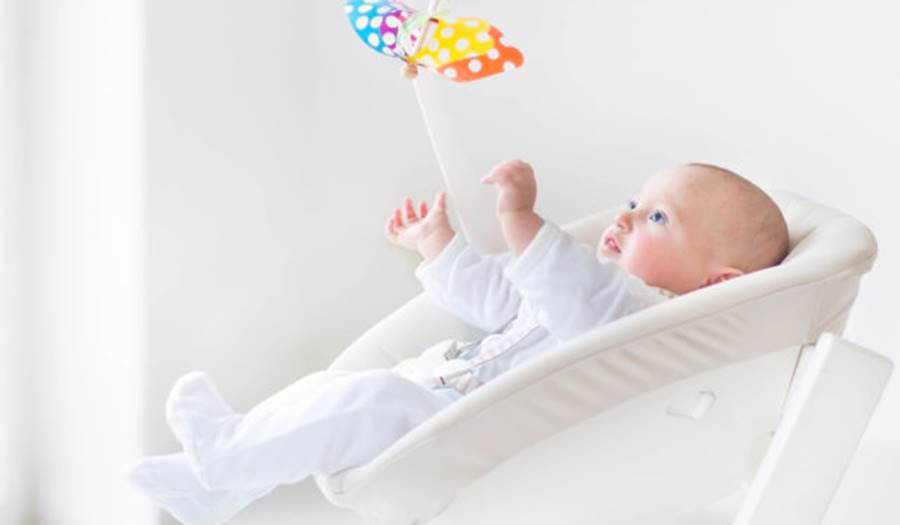
Baby Positioners And Containers
8/16/2021
Babies are tiny, but they seem to need a lot of gear! Most of us have or had a house full of baby gear including swings, bouncy seats, sleep positioners and jumpers. Today we are going to discuss baby gear, safety regulations, and how and when our babies should (or shouldn’t) be using this gear.
BABY GEAR
Not all baby gear is necessary or even safe. But how do you know if the items you are using with your baby are safe? Or are being used correctly?
SAFETY REGULATIONS
Did you know there is very limited safety testing done on infant gear? Most baby products are designed by engineers and salespeople. They are NOT developed by infant experts such as pediatricians, pediatric physical therapist, or pediatric occupational therapist, and they are NOT based on research. Many of the “recommendations” made for these products are NOT made by people who specialist in pediatric anatomy, physiology, or development.
On example, the Fisher Price Rock ‘n Play, was developed by engineers and marketers. They use no clinical research to develop this product. They did not use information about infant sleep or safe sleep. They never consulted pediatricians or other newborn or infant experts. In fact, the first time they consulted a pediatrician was 8 years AFTER the product was released and only consulted in relation to a lawsuit against the company. This item is now recalled due to the risk of infant death while using this product.
Many products claim they are safe. They claim their product has undergone safety testing. This testing and the standards are created and designed by the company making the product. Another company may do a different test with different standards. These tests do not have to measure up to an industry standard because there are no industry standards.
Items that have no industry safety standards but are often advertise as having passed safety testing include:
• car seat add-ons (never ok unless allowed by your car seat manufacturer, check your manual)
• lounger style pillows
• infant sleep positioners such as doc-a-tots
• infant seats
• bath seats
• walkers
• jumpers
• exersaucers
The only safety standard that must be met is related to chemicals only. Toys must be free of lead and phthalates. Because their safety seal does not specify this information, it can seem like the item is safety testing in other ways related to the equipment and use. These seals of safety ONLY related to chemicals and never to function.
So how can we know if an item is safe? First, make sure you read the manual that comes with the item. Make sure you are using it ONLY as directed. Note any warnings that come with the item. If the item requires supervision, it is NOT okay for your infant to use this during sleep. Also make sure to register your gear and stay alert for any recalls. In addition to these tasks, examine each item and ask yourself
• Can my baby fall out of this?
• Can any part of this pinch or damage my baby’s skin?
• Can any part of this cause strangulation?
It can be hard as a parent to know what to use and how to do it safely. Luckily there are organizations trying to help you figure this out. Here are a few:
Kids In Danger provides information about the safety of children’s products and recommendations on how to protect your child.
Make Safe Happen is a website that provides safety tips and product information. They also have an app available.
Juvenile Products Manufacturers Association provides information about safe children’s products and advocates for safe product certification.
The United States Consumer Product Safety Commission provides safety and recall information for many products including infant and children items.
Recalls provides recall information for over 15,000 consumer products including children’s items.
We are also going to go through the most common baby items and discuss the safety of these, the risks, the benefits, and the effect they may have on your child.
SLEEPING GEAR
Every year 3600 infants die while sleeping. The safest way for your baby to sleep is flat on their back, on a firm surface, with no blankets, stuffed animals, pillows, or positioners. Despite this American Academy of Pediatric warning, may sleep positioners are sold every year. In 2019, there were 21 deaths and 254 incidents related to products marketed for infant sleep. The majority of these deaths were due to asphyxiation or from falls.
As of June 2nd, 2021, the Consumer Product Safety Commission has a new rule that any sleep product marketed for babies under 5 months of age are actually safe for sleep. This means they no longer will be able to market inclined sleepers, in-bed sleepers, baby boxes, sleep hammocks, or bassinets without stands as safe sleeping solutions. This rule will not be enforced until mid-2022 so you can still find and buy products that do not comply with this rule. The only products that will be marketed for safe sleep are full sized cribs, non-full sized cribs, bassinets or cradles with stands, play yards, or bedside sleepers. They will be looking into the sale of bumpers and mattresses in late 2021.
LOUNGE PODS
The Snuggle Me and Doc-A-Tot are two brands of lounge pods originally marketed for co-sleeping. These are NOT approved by the American Academy of Pediatrics for sleep. Despite no longer being marketed as co-sleepers, they are often still used this way. The product includes the warning to NOT use this item for sleep, in a bassinet, or in a crib. These positioners are recommended to use for lounging in a cozy and supportive environment, tummy time, and support for early sitters.
These lounge pods should never be used for sleep as it poses a suffocation risk. If your baby sleeps in this container, it will make it harder to transition your baby to a flat sleeping surface. This product should only be limited in use for “lounging” as it restricts the freedom of your child to move. If your child cannot move, they are at increased risk for muscle tightness as well as plagiocephaly (flattening of the skull).


LOUNGE PILLOWS
In addition to lounge pods, there are lounge pillows. Brands include the Boppy Lounger, the Leachco Podster, the BabyMoov Cozydream, and the Hippapop Day Dreamer among others. These all are marketed for “busy parents to help you keep your hands free and give you more time.” Despite that benefit, they should be used sparingly. Frequent use of these positioners increases the risk of plagiocephaly and torticollis. Frequent use can also result in motor delays.




PLAGIOCEPHALY PILLLOWS
There are also companies that sell sleep items to prevent plagiocephaly such as plagiocephaly pillows or roll prevention wedges. These are NOT recommended by the AAP as they are extra items in the crib that can pose a suffocation risk. Research also shows no evidence that they improve or change head shape.



BASSINETS
Bassinets are great places for your newborn to sleep. The flat mattress decreases the risk of plagiocephaly by allowing free head and neck movement. Bassinets should NOT have any padding, bumper, or soft bedding. It should also be secure and not at risk for tipping or falling. If you use a bassinet that attaches to a play yard, make sure it is installed securely before using it with your infant. Once your baby is moving or rolling, you should move your baby to a crib.


The SNOO bassinet is popular with parents. This bassinet has a firm mattress and breathable edges. However, this bassinet comes with a built-in swaddle. Because the swaddle is part of the mattress it reduces your baby’s movement. This can inhibit baby’s natural rocking and movement during sleep. This in turn can depress your infant’s vestibular system (the system responsible for balance). It also increases the risk of plagiocephaly and torticollis (a tight neck muscle that limits head movement).

CARRIERS
Carriers are a great way to carry your baby, allow them to be close, help your child calm themselves as well as a great place for a nap. If your baby is using a carrier, they should be rear facing until 6 months of age when they have good head and neck control AND they are at decreased risk of hip dislocation. You should also avoid forward facing if your child has hip dysplasia or low muscle tone. You should also only have your child face forward if the carrier is designed to also be used forward facing, not all are. Your child should also not sleep in the carrier facing forward as this can cause positional asphyxiation.
When using a carrier, your baby’s spine should retain its’ natural C shaped curve. Their spine should not be straight or overextended. Your baby’s knees should be level or higher than their hips in an M shape. This allows for proper hip positioning. Not all carriers allow this positioning. A list of hip healthy carriers can be found at International Hip Dysplasia Institute. You should also be able to kiss your baby’s head when they are in the carrier.



SEATS AND SWINGS
As with other baby equipment, any type of seat or swing should never be used for sleep. Babies should not be upright for sleep. This can result in positional asphyxiation due to poor head control and weak neck muscles. Seats can also pose a strangulation risk when babies who move and are unsupervised move enough to get caught in the straps. Seats should always be used on the floor and safety harnesses should be snug. Seats and swings should only be used for 10-30 minutes a day maximum.
BOUNCY SEATS AND SWINGS
A bouncy seat is a lounge type chair for you infant and baby but keeps them more upright. They can be helpful to busy parents to be able to put your infant down but still allow them to see you.
Swings are seats that swing and/or vibrate. They stimulate the deep vestibular system in infants and can be very calming. When you have a fussy baby, they can be a godsend.
A bouncy seat or swing should be used less than 30 minutes a day. If used too much these seats can result in back muscles becoming TOO developed. This will cause a child to throw themselves backward when put in a sitting position or swim on their belly and not bear weight on their arms during tummy time.
Also, if your child spends time in their seat or swing and isn’t perfectly upright, meaning they are leaning over or always has their head turned, they can develop muscle tightness. This increases the risk of torticollis, plagiocephaly, and motor delays. To prevent this, when your child is using these seats make sure their nose is in line with their belly button.




CONTAINER SEAT
Container seats or sitting trainers have become popular over the past decade. These seats place baby in an upright position. They often are marketed in helping children learn how to sit or to be used as an early feeding highchair. But not every chair is helping your child! Some chairs actually make it HARDER for your infant to sit! Because these seats are for babies working on sitting, they should NOT be used before 5 months of age. This is the time when your baby’s body is ready to work on sitting.
Choosing the correct seat is important. The old floor seat style Bumbo seat puts the pelvis in the wrong position forcing an over-curved spine. It also forces the knees higher than the hips. The back, pelvic, and hip positioning makes it very hard to sit! Additionally, this seat is not adjustable for growth.
The Bumbo Multi-seat, the Upseat are much better options. The Bumbo multi-seat has a level seat base allowing the hips and knees to be in alignment which aids in sitting. It has a removable pad to take out as the child grows. Additionally, the back support comes higher up but not too high up. There is also a removable tray that can facilitate mid-line play.
The Upseat has wide leg holes, and the hip area is higher than the knees which helps put a child into a better supported sit position. Like the Bumbo, the Upseat gives great back support, has a tray to help with midline play, and has a removable growth pad.
If your child is trying to sit before that age, a good option is the Sit Me Up Chair. This can be used with babies 3 months and older. It provides good vertical support. The crossbar should be at the nipple line so if your baby is smaller, you can place a folded towel under their bum to help raise them up to the correct height.



BATH SEATS
Bath seats are marketed as a must have. Unfortunately, they give parents a false sense of security. A bath seat is a bathing aid NOT a safety device. Because of this they are not recommended by the American Academy of Pediatrics.
If you do choose to use a bath seat, you must always supervise your child. The bath seat can tip over easily which may result in drowning. Like non-bath container seats, the bath seat should have a flat bottom and a back that goes up to the shoulder blades. One example of such seat is the Swivel bath seat or the Summer Infant bath seat.


ACTIVITY OR ENTERTAINMENT CONTAINERS
EXERSAUCERS
Exersaucers are another container that helps you keep your child stationary but provides entertainment by allowing them to bounce, spin, and play with toys. Despite the age range listed on most of these items starting at 4 months, they should not be used until 6-7 months of age. This is because these seats put your child’s hips in a bad position that increase the risk of hip dislocation. When in the exersaucer, their feet should be flat. They should not be raised on their toes.


JUMPERS
Jumpers are also a heavily marketed baby item that provides containment as well as entertainment. These are marketed for babies 3 months and older. This is a recommendation from the company, and remember, they often do not consult infant or child experts on these recommendations. Physical therapists recommend NEVER using stationary jumpers or doorway jumpers. Children’s bodies are not ready to jump until they are 20-24 months of age. Jumping at a much earlier age, such as the company recommended 3+ months can result in
• Increased in-toeing (toes turning in while walking)
• Increased risk of toe walking
• Increased risk of hip dislocation
• Change in leg alignment
• Overdeveloped calf muscles
• Risk of injury from doorway jumpers due to colliding with doorjamb or falling



WALKERS
Sit in walkers are another heavily marketed baby item that provides entertainment for your infant. Sit in walkers are deemed unsafe per the American Academy of Pediatrics. They are banned in most other countries due to the safety issues and risk of harm. Walkers cause 2900 emergency visits each year due to falls or entrapment. They also allow children access to items that they may be able to pull over and fall on them. Most of these injuries occur when an adult is watching but isn’t close enough or can’t react quickly enough to prevent injury.
There are NO physical benefits to walkers. Despite being called “walkers”, they actually result in delayed independent walking. They increase the risk of toe walking and can also result in improper foot alignment.


Push walkers, however, are a great alternative to a sit-in walker. Push walkers encourage upright walking. Using a push walker increases leg and ankle strength, promotes back extension, and helps shifts your child’s weight to their heels thereby reducing the incidence of toe walking. It also helps slow your child’s walking down which helps increase control and builds confidence.


CONTAINER BABY SYNDROME
Container Baby Syndrome is a diagnosis that we are increasingly seeing from babies spending too much time in containers such as the ones discussed above.. This excessive time in containers results in torticollis (a tight muscle resulting in limited head mobility), plagiocephaly (a misshapen head due to pressure more to one area), gross motor delays, social-emotional delays, and delayed cognitive development.
Containers and baby gear are there to help parents. There is very limited data showing they help your child. The importance of containers is all marketing and not research based. The marketing tactics and advertising ignores research and safety recommendations and plays to your need for help as parents.
Containers can hinder development by making sitting or standing easier. This means when your child is working on skills such as sitting, rolling, crawling, or walking they may become frustrated more easily. It is hard work to work on those skills. For example, when they are standing in an exersaucer they are supported on all sides and able to stabilize themselves by locking out their joints. When working on sitting in a container, they have support on all sides. When standing or sitting on their own, they must use all their own muscles for strength and balance. They more time spent in a container, the less they will tolerate the work of development.
A container should NEVER be expected to each your child a specific skill. We all use some form of containers at some point. The goal should be to avoid unsafe containers such as jumpers and walkers and to avoid allowing sleep in any unsafe containers. Container use should be limited. Play in an open area should be encouraged. For every 10-15 minutes a child spends in a container, they should spend double that amount of time on the floor playing on their back, sides, and doing tummy time. And your child should always be supervised while using a container.
Companies take advantage of new parents, tired parents, and busy parents. They push marketing with no regard for safety or the effect their product will have on infants and their development. Learning about these items, the risks, benefits, and effects they may have on your child will help you choose the right product and usage for your child and your family.
Children’s Health Care of Newburyport, Massachusetts, and Haverhill, Massachusetts is a pediatric healthcare practice providing care for families across the North Shore, Merrimack Valley, southern New Hampshire, and the Seacoast regions. The Children’s Health Care team includes pediatricians and pediatric nurse practitioners who provide comprehensive pediatric health care for children, including newborns, toddlers, school-aged children, adolescents, and young adults. Our child-centered and family-focused approach covers preventative and urgent care, immunizations, and specialist referrals. Our services include an on-site pediatric nutritionist, special needs care coordinator, and social workers. We also have walk-in appointments available at all of our locations for acute sick visits. Please visit chcmass.com where you will find information about our pediatric doctors, nurse practitioners, as well as our hours and services.
Disclaimer: this health information is for educational purposes only. You, the reader, assume full responsibility for how you choose to use it.








